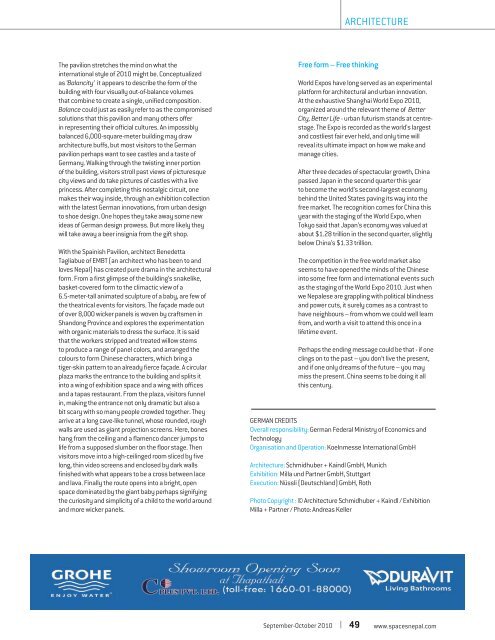5. September - October 2010
Create successful ePaper yourself
Turn your PDF publications into a flip-book with our unique Google optimized e-Paper software.
ARCHITECTURE<br />
The pavilion stretches the mind on what the<br />
international style of <strong>2010</strong> might be. Conceptualized<br />
as ‘Balancity’ it appears to describe the form of the<br />
building with four visually out-of-balance volumes<br />
that combine to create a single, unified composition.<br />
Balance could just as easily refer to as the compromised<br />
solutions that this pavilion and many others offer<br />
in representing their official cultures. An impossibly<br />
balanced 6,000-square-meter building may draw<br />
architecture buffs, but most visitors to the German<br />
pavilion perhaps want to see castles and a taste of<br />
Germany. Walking through the twisting inner portion<br />
of the building, visitors stroll past views of picturesque<br />
city views and do take pictures of castles with a live<br />
princess. After completing this nostalgic circuit, one<br />
makes their way inside, through an exhibition collection<br />
with the latest German innovations, from urban design<br />
to shoe design. One hopes they take away some new<br />
ideas of German design prowess. But more likely they<br />
will take away a beer insignia from the gift shop.<br />
With the Spainish Pavilion, architect Benedetta<br />
Tagliabue of EMBT (an architect who has been to and<br />
loves Nepal) has created pure drama in the architectural<br />
form. From a first glimpse of the building’s snakelike,<br />
basket-covered form to the climactic view of a<br />
6.5-meter-tall animated sculpture of a baby, are few of<br />
the theatrical events for visitors. The façade made out<br />
of over 8,000 wicker panels is woven by craftsmen in<br />
Shandong Province and explores the experimentation<br />
with organic materials to dress the surface. It is said<br />
that the workers stripped and treated willow stems<br />
to produce a range of panel colors, and arranged the<br />
colours to form Chinese characters, which bring a<br />
tiger-skin pattern to an already fierce façade. A circular<br />
plaza marks the entrance to the building and splits it<br />
into a wing of exhibition space and a wing with offices<br />
and a tapas restaurant. From the plaza, visitors funnel<br />
in, making the entrance not only dramatic but also a<br />
bit scary with so many people crowded together. They<br />
arrive at a long cave-like tunnel, whose rounded, rough<br />
walls are used as giant projection screens. Here, bones<br />
hang from the ceiling and a flamenco dancer jumps to<br />
life from a supposed slumber on the floor stage. Then<br />
visitors move into a high-ceilinged room sliced by five<br />
long, thin video screens and enclosed by dark walls<br />
finished with what appears to be a cross between lace<br />
and lava. Finally the route opens into a bright, open<br />
space dominated by the giant baby perhaps signifying<br />
the curiosity and simplicity of a child to the world around<br />
and more wicker panels.<br />
Free form – Free thinking<br />
World Expos have long served as an experimental<br />
platform for architectural and urban innovation.<br />
At the exhaustive Shanghai World Expo <strong>2010</strong>,<br />
organized around the relevant theme of Better<br />
City, Better Life - urban futurism stands at centrestage.<br />
The Expo is recorded as the world's largest<br />
and costliest fair ever held, and only time will<br />
reveal its ultimate impact on how we make and<br />
manage cities.<br />
After three decades of spectacular growth, China<br />
passed Japan in the second quarter this year<br />
to become the world’s second-largest economy<br />
behind the United States paving its way into the<br />
free market. The recognition comes for China this<br />
year with the staging of the World Expo, when<br />
Tokyo said that Japan’s economy was valued at<br />
about $1.28 trillion in the second quarter, slightly<br />
below China’s $1.33 trillion.<br />
The competition in the free world market also<br />
seems to have opened the minds of the Chinese<br />
into some free form and international events such<br />
as the staging of the World Expo <strong>2010</strong>. Just when<br />
we Nepalese are grappling with political blindness<br />
and power cuts, it surely comes as a contrast to<br />
have neighbours – from whom we could well learn<br />
from, and worth a visit to attend this once in a<br />
lifetime event.<br />
Perhaps the ending message could be that - if one<br />
clings on to the past – you don’t live the present,<br />
and if one only dreams of the future – you may<br />
miss the present. China seems to be doing it all<br />
this century.<br />
GERMAN CREDITS<br />
Overall responsibility: German Federal Ministry of Economics and<br />
Technology<br />
Organisation and Operation: Koelnmesse International GmbH<br />
Architecture: Schmidhuber + Kaindl GmbH, Munich<br />
Exhibition: Milla und Partner GmbH, Stuttgart<br />
Execution: Nüssli (Deutschland) GmbH, Roth<br />
Photo Copyright : © Architecture Schmidhuber + Kaindl / Exhibition<br />
Milla + Partner / Photo: Andreas Keller<br />
<strong>September</strong>-<strong>October</strong> <strong>2010</strong><br />
49<br />
www.spacesnepal.com

















